Development of Intelligent Prefabs Using IoT Technology to Improve the Performance of Prefabricated Construction Projects
Abstract
1. Introduction
2. Literature Review
2.1. Internet of Things (IoTs)
2.2. Positioning
2.3. LoRa
2.4. Structural Health Monitoring System
2.5. Dynamic BIM
2.6. Gaps in Existing Literature
3. Proposed Method
3.1. RFID Technology
3.2. Structural Performance Monitoring
3.3. Data Transmission
3.4. Data Management
3.5. Cloud-Based BIM
4. Practical Application of the Proposed Method
4.1. Sensor Network Test
4.1.1. Sensor Test
4.1.2. LoRa Network Test
4.2. Field Test
4.2.1. Location of a Prefabrication (PC) Component
4.2.2. Monitoring Results of Strain Level
4.2.3. The Developed Cloud-based BIM Model
5. Discussion and Conclusions
Author Contributions
Funding
Acknowledgments
Conflicts of Interest
Abbreviations
| AEC | Architectural, Engineering, and Construction |
| AoA | Angle of Arrival |
| BIM | Building Information Modelling |
| BMS | Building Management System |
| BW | Band Width |
| CR | Coding Rate |
| FBG | Fiber Bragg Grating |
| FEA | Finite Element Analysis |
| GPS | Global Positioning System |
| GUID | Global Unique Identifier |
| HTML | Hypertext Markup Language |
| ID | Identification |
| IEEE | Institute of Electrical and Electronics Engineers |
| IFC | Industry Foundation Classes |
| IMU | Inertial Measurement Unit |
| IoTs | Internet of Things |
| ISO | International Organization for Standardization |
| LoRa | Long Range |
| LoRaWAN | Long Range Wide Area Network |
| MVC | Model View Controller |
| PC | Prefabrication |
| RFID | Radio Frequency Identification |
| RSSI | Received Signal Strength Indicator |
| SF | Spreading Factor |
| SHM | Structural Health Monitoring |
| SPAN | Synchronized Position Attitude Navigation |
| SQL | Structured Query Language |
| TCP/IP | Transmission Control Protocol/Internet Protocol |
| ToA | Time of Arrival |
| USB | Universal Serial Bus |
| UWB | Ultra-Wide Band |
| WLAN | Wireless Local Area Network |
References
- Li, Z.; Shen, G.Q.; Alshawi, M. Measuring the impact of prefabrication on construction waste reduction: An empirical study in China. Resour. Conserv. Recycl. 2014, 91, 27–39. [Google Scholar] [CrossRef]
- Wang, J.; Li, Z.; Tam, V.W. Identifying best design strategies for construction waste minimization. J. Clean. Prod. 2015, 92, 237–247. [Google Scholar] [CrossRef]
- Hong, J.; Shen, G.Q.; Mao, C.; Li, Z.; Li, K. Life-cycle energy analysis of prefabricated building components: An inputeoutput-based hybrid model. J. Clean. Prod. 2016, 112, 2198–2207. [Google Scholar] [CrossRef]
- Xu, G.; Li, M.; Chen, C.H.; Wei, Y. Cloud asset-enabled integrated IoT platform for lean prefabricated construction. Automat. Construct. 2018, 93, 123–134. [Google Scholar] [CrossRef]
- Li, X.; Shen, G.Q.; Wu, P.; Yue, T. Integrating Building Information Modeling and Prefabrication Housing Production. Automat. Construct. 2019, 100, 46–60. [Google Scholar] [CrossRef]
- Liu, D.; Wu, Y.; Li, S.; Sun, Y. A real-time monitoring system for lift-thickness control in highway construction. Autom. Constr. 2016, 63, 27–36. [Google Scholar] [CrossRef]
- Shi, W.; Wu, C.; Wang, X. A Prototype Tool of Optimal Wireless Sensor Placement for Structural Health Monitoring. In Proceedings of the 25th EG-ICE International Workshop, Lausanne, Switzerland, 10–13 June 2018. [Google Scholar]
- Taheri, S. A review on five key sensro for monitoring of concrete structures. Construct. Build. Mater. 2019, 204, 492–509. [Google Scholar] [CrossRef]
- Das, S.; Saha, P. A review of some advanced sensors used for health diagnosis of civil engineering structures. Measurement 2018, 129, 68–90. [Google Scholar] [CrossRef]
- Perera, R.; Marin, R.; Ruiz, A. Static–dynamicmulti-scalestructuraldamageidentification in amulti-objectiveframework. J. Sound Vib. 2013, 332, 1484–1500. [Google Scholar] [CrossRef]
- Xu, D.L.; He, W.; Li, S. Internet of things in industries: A survey. IEEE Trans. Ind. Inf. 2014, 10, 2233–2243. [Google Scholar] [CrossRef]
- Kochovski, P.; Stankovski, V. Supporting smart construction with dependable edge computing infrastructures and applications. Automat. Construct. 2018, 85, 182–192. [Google Scholar] [CrossRef]
- Rajeswari, S.; Kannan, S.; Rajakumar, K. A smart agricultural model by integrating IoT, mobile and cloud-based big data analytics. In Proceedings of the 2017 International Conference on Intelligent Computing and Contro, Madurai, India, 15–16 June 2017; pp. 1–5. [Google Scholar]
- Wang, H.; Liu, D. Is servitization of construction the inevitable choice of Internet Plus construction? Front. Eng. Manag. 2017, 4, 229–230. [Google Scholar] [CrossRef][Green Version]
- Valero, E.; Adán, A.; Cerrada, C. Evolution of RFID Applications in Construction: A Literature Review. Sensors 2015, 15, 15988–16008. [Google Scholar] [CrossRef]
- Shin, T.H.; Chin, S.; Yoon, S.W.; Kwon, S.W. A service-oriented integrated information framework for RFID/WSN-based intelligent construction supply chain management. Automat. Construct. 2011, 20, 706–715. [Google Scholar] [CrossRef]
- Chen, Y.; Kamara, J.M. A framework for using mobile computing for information management on construction sites. Automat. Construct. 2011, 20, 776–788. [Google Scholar] [CrossRef]
- Wang, H.; Gluhak, A.; Meissner, S.; Tafazolli, R. Integration of BIM and live sensing information to monitor building energy performance. In Proceedings of the 30th CIB (International Council for Research and Innovation in Building and Construction) International Conference, Brisbane, QLD, Australia, 5–9 May 2013. [Google Scholar]
- Ko, H.S.; Azambuja, M.; Lee, H.F. Cloud-based materials tracking system prototype integrated with radio frequency identification tagging technology. Automat. Construct. 2016, 63, 144–154. [Google Scholar] [CrossRef]
- Riaz, Z.; Arslan, M.; Kiani, A.K.; Azhar, S. CoSMoS: A BIM and wireless sensor based integrated solution for worker safety in confined spaces. Autom. Constr. 2014, 45, 96–106. [Google Scholar] [CrossRef]
- Fang, Y.; Cho, Y.K.; Zhang, S.; Perez, E. Case study of BIM and cloud-enabled real time RFID indoor localization for construction management applications. J. Constr. Eng. Manag. 2016, 142. [Google Scholar] [CrossRef]
- Montaser, A.; Bakry, I.; Alshibani, A.; Moselhi, O. Estimating productivity of earthmoving operations using spatial technologies. Can. J. Civil Eng. 2012, 39, 1072–1082. [Google Scholar] [CrossRef]
- Diggelen, F.V. Indoor GPS theory and implementation. In Proceedings of the IEEE Position Location and Navigation Symposium, Piscataway, NJ, USA, 15–18 April 2002; pp. 240–247. [Google Scholar]
- Teizer, J.; Lao, D.; Sofer, M. Rapid automated monitoring of construction site activities using ultra-wideband. In Proceedings of the 24th international Symposium on Automation & Robotics in Construction (ISARC), Madras, OR, USA, 19–21 September 2007; pp. 23–28. [Google Scholar]
- Aryan, A. Evaluation of Ultra-Wideband Sensing Technology for Position Location in Indoor Construction Environments. Master’s Thesis, University of Waterloo, Waterloo, ON, Canada, 2011. [Google Scholar]
- Woo, S.; Jeong, S.; Mok, E.; Xia, L.; Choi, C.; Pyeon, M.; Heo, J. Application of WiFi-Based indoor positioning system for labor tracking at construction sites: A case study in Guangzhou MTR. J. Automat. Construct. 2011, 20, 3–13. [Google Scholar] [CrossRef]
- Hightower, J.; Borriello, G. Location systems for ubiquitous computing. Computer 2001, 34, 57–66. [Google Scholar] [CrossRef]
- Al Nuaimi, K.; Kamel, H. A survey of indoor positioning systems and algorithms. In Proceedings of the International Conference on Innovations in Information Technology, Abu Dhabi, UAE, 25–27 April 2011; pp. 185–190. [Google Scholar]
- Patwari, N.; Ash, J.N.; Kyperountas, S.; Hero, A.O.; Moses, R.L.; Correal, N.S. Locating the nodes: Cooperative localization in wireless sensor networks. Signal. Process. Mag. 2005, 22, 54–69. [Google Scholar] [CrossRef]
- Ergen, E.; Akinci, B.; East, B.; Kirby, J. Tracking components and maintenance history within a facility utilizing radio frequency identification technology. J. Comput. Civil. Eng. (ASCE) 2007, 21, 11–20. [Google Scholar] [CrossRef]
- Ergen, E.; Akinci, B.; Sacks, R. Tracking and locating components in a precast storage yard utilizing radio frequency identification technology and GPS. J. Automat. Construct. 2007, 16, 354–367. [Google Scholar] [CrossRef]
- Li, H.; Chan, G.; Wong, J.K.W.; Skitmore, M. Real-time locating systems applications in construction. Autom. Constr. 2016, 63, 37–47. [Google Scholar] [CrossRef]
- Kennedy, S.; Hamilton, J.; Martell, H. Architecture and system performance of SPANNovAtel’s GPS/INS solution. In Proceedings of the 2006 IEEE/ION Position, Location, And Navigation Symposium, San Diego, CA, USA, 25–27 April 2006. [Google Scholar]
- Taneja, S.; Akcamete, A.; Akinci, B.; Garrett, J.H., Jr.; Soibelman, L.; East, E.W. Analysis of three indoor localization technologies for supporting operations and maintenance field tasks. J. Comput. Civ. Eng. 2011, 26, 708–719. [Google Scholar] [CrossRef]
- Ding, L.Y.; Zhou, C.; Deng, Q.X.; Luo, H.B.; Ye, X.W.; Ni, Y.Q.; Guo, P. Real-time safety early warning system for cross passage construction in Yangtze riverbed metro tunnel based on the internet of things. Autom. Constr. 2013, 36, 25–37. [Google Scholar] [CrossRef]
- Cheng, T.; Teizer, J. Real-time resource location data collection and visualization technology for construction safety and activity monitoring applications. Autom. Constr. 2013, 34, 3–15. [Google Scholar] [CrossRef]
- Aoudia, F.A.; Gautier, M.; Magno, M.; Gentil, M.L.; Berder, O.; Benini, L. Long-short range communication network leveraging LoRa™ and wake-up receiver. Microprocess. Microsyst. 2018, 56, 184–192. [Google Scholar] [CrossRef]
- LoRa Alliance. LoraWAN™, Specification v1.0; Lora Alliance, Inc.: San Ramon, CA, USA, 2015. [Google Scholar]
- IEEE. IEEE Standard for Local and Metropolitan Area Networkspart 15.4: Low-Rate Wireless Personal Area Networks (LR-WPANs); IEEE: Piscataway, NJ, USA, 2011. [Google Scholar]
- Goursaud, C.; Gorce, J. Dedicated Networks for IoT:PHY/MAC State of the Art and Challenges; EAI Endorsed Transactions on Internet of Things: Bratislava, Slovakia, 2015. [Google Scholar]
- Pham, C. Building Low-Cost Gateways and Devices for Open LoRa IoT Test-Beds. In International Conference on Testbeds and Research Infrastructures; Guo, S., Wei, G., Xiang, Y., Lin, X., Lorenz, P., Eds.; Springer: New York, NY, USA, 2016. [Google Scholar]
- Semtech LoRa modulation basics. Available online: https://www.rfwireless-world.com/Terminology/LoRa-modulation-vs-CSS-modulation.html (accessed on 20 August 2019).
- Wixted, A.J.; Kinnaird, P.; Larijani, H.; Tait, A.; Ahmadinia, A.; Strachan, N. Evaluation of LoRa and LoRaWAN for wireless sensor networks. In Proceedings of the SENSORS, 2016 IEEE, Orlando, FL, USA, 30 October–2 November 2016; pp. 1–3. [Google Scholar]
- Li, L.; Ren, J.; Zhu, Q. On the application of LoRa LPWAN technology in sailing monitoring system. In Proceedings of the 13th Annual Conference on Wireless On-demand Network Systems and Services (WONS), Seattle, WA, USA, 31 October–3 November 2017; pp. 77–80. [Google Scholar]
- Vatcharatiansakul, N.; Tuwanut, P.; Pornavalai, C. Experimental performance evaluation of LoRaWAN: A case study in Bangkok. In Proceedings of the 14th International Joint Conference on Computer Science and Software Engineering (JCSSE), Nakhon Si Thammarat, Thailand, 12–14 July 2017; pp. 1–4. [Google Scholar]
- Mikhaylov, K.; Petäjäjärvi, J.; Janhunen, J. On LoRaWAN scalability: Empirical evaluation of susceptibility to inter-network interference. In Proceedings of the Networks and Communications (EuCNC), 2017 European Conference, Oulu, Finland, 12–15 June 2017; pp. 1–6. [Google Scholar]
- Georgiou, O.; Raza, U. Low power wide area network analysis: Can LoRa scale? IEEE Wireless Commun. Lett. 2017, 6, 162–165. [Google Scholar] [CrossRef]
- Bor, M.; Roedig, U. LoRa Transmission parameter selection. In Proceedings of the 13th International Conference on Distributed Computing in Sensor Systems (DCOSS), Ottawa, ON, Canada, 5–7 June 2017; pp. 27–34. [Google Scholar]
- Lim, J.T.; Han, Y. Spreading factor allocation for massive connectivity in LoRa systems. IEEE Commun. Lett. 2018, 22, 800–803. [Google Scholar] [CrossRef]
- Babazadeh, M. Edge analytics for anomaly detection in water networks by an Arduino101-LoRa based WSN. ISA Trans. 2019. [Google Scholar] [CrossRef]
- Hassan, W.; Føre, M.; Ulvund, J.B.; Alfredsen, J.A. Internet of Fish: Integration of acoustic telemetry with LPWAN for efficient real-time monitoring of fish in marine farms. Comput. Electron. Agric. 2019, 163, 1–9. [Google Scholar] [CrossRef]
- Addabbo, T.; Fort, A.; Mugnaini, M.; Panzardi, E.; Pozzebon, A.; Vignoli, V. A city-scale IoT architecture for monumental structures monitoring. Measurement 2019, 131, 349–357. [Google Scholar] [CrossRef]
- Lynch, J.P. A summary review of wireless sensors and sensor networks for structural health monitoring. Shock Vib. Digest 2006, 38, 91–128. [Google Scholar] [CrossRef]
- Bhalla, S.; Soh, C.K. High frequency piezoelectric signatures for diagnosis of seismic/blast induced structural damages. NDT&E Int. 2004, 37, 23–33. [Google Scholar]
- Mal, A.; Ricci, F.; Banerjee, S.; Shih, F. A conceptual structural health monitoring system based on vibration and wave propagation. Struct. Health Monit. 2005, 4, 283–293. [Google Scholar] [CrossRef]
- Song, G.; Gu, H.; Mo, Y.L.; Hsu, T.T.C.; Dhonde, H. Concrete structural health monitoring using embedded piezoceramic transducers. Smart Mater. Struct. 2007, 16, 959–968. [Google Scholar] [CrossRef]
- Sevillano, E.; Sun, R.; Perera, R. Damage Detection Based on Power Dissipation Measured with PZT Sensors through the Combination of Electro-Mechanical Impedances and Guided Waves. Sensors 2016, 16, 639. [Google Scholar] [CrossRef]
- Perera, R.; Pérez, A.; García-Diéguez, M.; Zapico-Valle, J.L. ActiveWireless System for Structural Health Monitoring Applications. Sensors 2017, 17, 2880. [Google Scholar] [CrossRef]
- Ye, X.W.; Su, Y.H.; Han, J.P. Structural health monitoring of civil infrastructure using optical fiber sensing technology: A comprehensive review. Sci. World J. 2014. [Google Scholar] [CrossRef]
- Roussel, M.; Glisic, B.; Lau, J.M.; Fong, C.C. Long-term monitoring of high-rise buildings connected by link bridges. J. Civil. Struct. Health Monit. 2014, 4, 57–67. [Google Scholar] [CrossRef]
- Wong, K.Y. Instrumentation and health monitoring of cable supported bridges. Struct. Control. Health Monit. 2004, 11, 91–124. [Google Scholar] [CrossRef]
- Jang, S.; Jo, H.; Cho, S.; Mechitov, K.; Rice, J.A.; Sim, S.H.; Jung, H.J.; Yun, C.B.; Spencer, B.F.J.; Agha, G. Structural health monitoring of a cable-stayed bridge using smart sensor technology: Deployment and evaluation. Smart Struct. Syst. 2010, 6, 439–459. [Google Scholar] [CrossRef]
- Magalhães, F.; Cunha, A.; Caetano, E. Vibration based structural health monitoring of an arch bridge: From automated OMA to damage detection. Mech. Syst. Signal. Process. 2012, 28, 212–228. [Google Scholar] [CrossRef]
- Hu, X.; Wang, B.; Ji, H. A wireless sensor network-based structural health mon- itoring system for highway bridges. Comput. Aided Civil. Infrastruct. Eng. 2013, 28, 193–209. [Google Scholar] [CrossRef]
- Tang, Y.C.; Li, L.J.; Feng, W.X.; Liu, F.; Zou, X.J.; Chen, M.Y. Binocular vision measurement and its application in full-field convex deformation of concrete-filled steel tubular columns. Measurement 2018, 130, 372–383. [Google Scholar] [CrossRef]
- Chen, M.; Tang, Y.; Zou, X.; Huang, K.; Li, L.; He, Y. High-accuracy multi-camera reconstruction enhanced by adaptive point cloud correction algorithm. Opt. Lasers Eng. 2019, 122, 170–183. [Google Scholar] [CrossRef]
- Costin, A.; Pradhananga, N.; Teizer, J. Leveraging passive RFID technology for construction resource field mobility and status monitoring in a high-rise renovation project. Automat. Construct. 2012, 24, 1–15. [Google Scholar] [CrossRef]
- Guven, G.; Ergen, E.; Erberik, M.A.; Kurc, O.; Birgönül, M.T. Providing guidance for evacuation during an emergency based on a real-time damage and vulnerability assessment of facilities. Comput. Civil. Eng. 2012, 586–593. [Google Scholar] [CrossRef]
- Dong, B.; O’Neill, Z.; Li, Z. A BIM-enabled information infrastructure for building energy fault detection and diagnostics. Autom. Constr. 2014, 44, 197–211. [Google Scholar] [CrossRef]
- Pasini, D.; Ventura, S.M.; Rinaldi, S.; Bellagente, P.; Flammini, A.; Ciribini, A.L.C. Exploiting Internet of Things and building information modeling framework for management of cognitive buildings. In Proceedings of the 2016 IEEE International Smart Cities Conference, Trento, Italy, 12–15 September 2016; pp. 1–6. [Google Scholar]
- Alves, M.; Carreira, P.; Aguiar Costa, A. BIMSL: A generic approach to the integration of building information models with real-time sensor data. Autom. Constr. 2017, 84, 304–314. [Google Scholar] [CrossRef]
- Khalid, M.U.; Bashir, M.K.; Newport, D. Development of a building information modelling (BIM)-based real-time data integration system using a building management system (BMS). In Building Information Modelling, Building Performance, Design and Smart Construction; Dastbaz, M., Gorse, C., Moncaster, A., Eds.; Springer: Basel, Switzerland, 2017. [Google Scholar]
- Wang, M.; Li, R.; Zhang, W. Application and Mechanics Analysis of Multi-function Construction Platforms in Prefabricated-Concrete Construction. Int. J. Eng. Technol. 2018, 10, 214–220. [Google Scholar] [CrossRef]
- Gunawardena, T.; Ngo, T.; Mendis, P.; Alfano, J. Innovative Flexible Structural System Using Prefabricated Modules. J. Archit. Eng. 2016, 22, 05016003. [Google Scholar] [CrossRef]
- Kong, X.; Li, J.; Laflamme, S.; Bennett, C.; Matamoros, A. Characterization of a soft elastomeric capacitive strain sensor for fatigue crack monitoring. In Proceedings of the SPIE Smart Structures and Materials + Nondestructive Evaluation and Health Monitoring, San Diego, CA, USA, 8–12 March 2015; pp. 1–10. [Google Scholar]
- Downey, A.; D’Alessandro, A.; Laflamme, S. Smart bricks for strain sensing and crack detection in masonry structures. Smart Mater. Struct. 2017, 27, 1–18. [Google Scholar] [CrossRef]
- Park, G.; Rosing, T.; Todd, M.D.; Farrar, C.R.; Hodgkiss, W. Energy harvesting for structural health monitoring sensor networks. J. Infrastruct. Syst. 2008, 14, 1–16. [Google Scholar] [CrossRef]
- Liu, T.; Yang, B.; Zhang, Q. Health monitoring system developed for Tianjin 117 high-rise building. J. Aerosp. Eng. 2017, 3, 1–13. [Google Scholar] [CrossRef]
- Demers, D. LoRa Networks in Buildings Reduce Infrastructure Costs. Available online: http://iotdesign.embedded-computing.com/articles/lora-networks-in-buildings-reduce-infrastructure-costs/ (accessed on 30 August 2019).
- International Organization for Standardization. Industry Foundation Classes (IFC) for Data Sharing in the Construction and Facility Management Industries; ISO: Geneva, Switzerland, 2013; Volume ISO 16739:2013. [Google Scholar]
- International Organization for Standardization. Industrial Automation Systems and Integration—Product Data Representation and Exchange—Part 11: Description Methods: The EXPRESS Language Reference Manual; ISO: Geneva, Switzerland, 2004. [Google Scholar]
- IFC. Industry Foundation Classes Release 4; Industry Foundation Classes: Washington, DC, USA, 2014. [Google Scholar]
- Motamedi, A.; Soltani, M.M.; Setayeshgar, S.; Hammad, A. Extending IFC to incorporate information of RFID tags attached to building elements. Adv. Eng. Inf. 2016, 30, 39–53. [Google Scholar] [CrossRef]
- Johansson, M.; Roupé, M.; Bosch-Sijtsema, P. Real-time visualization of building information models (BIM). Automat. Construct. 2015, 54. [Google Scholar] [CrossRef]
- Lin, J.; Zhang, J.; Wen, Q.; Wang, F. Leveraging BIM in Settlement Monitoring and Impact Management for Subway Excavation. In Proceedings of the 32nd CIB W78 Conference, Eindhoven, The Netherlands, 27–29 October 2015; pp. 469–477. [Google Scholar]
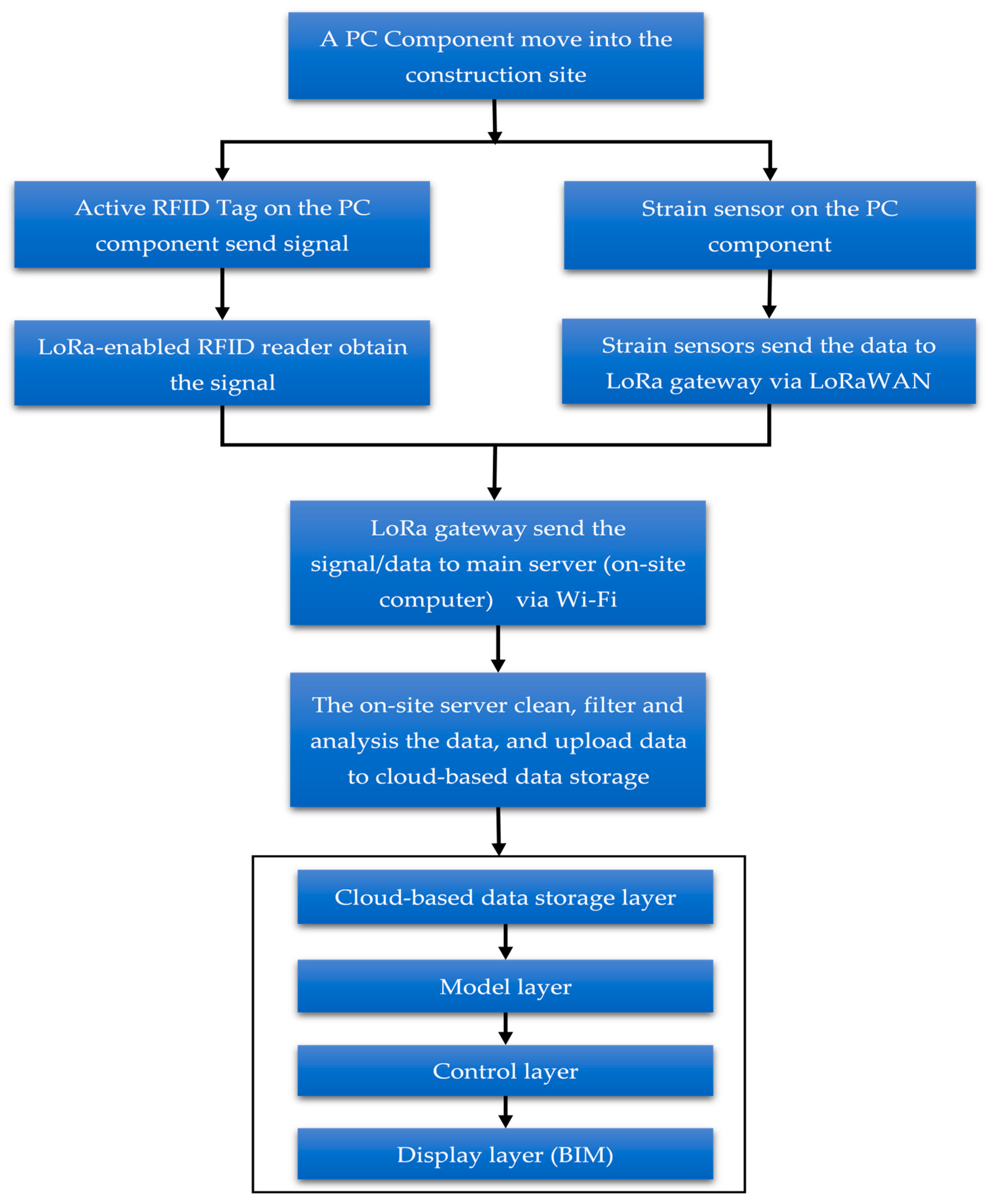
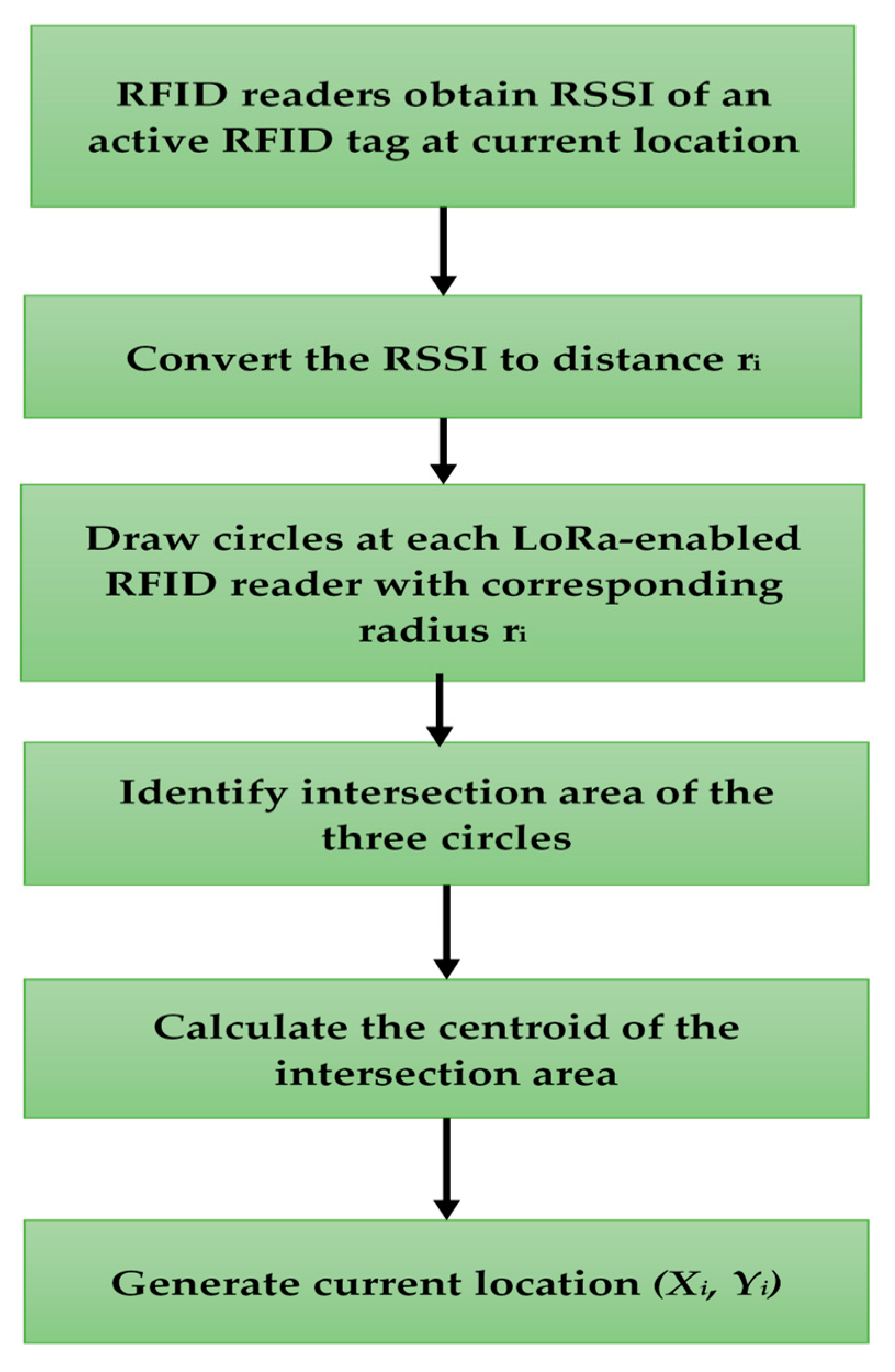


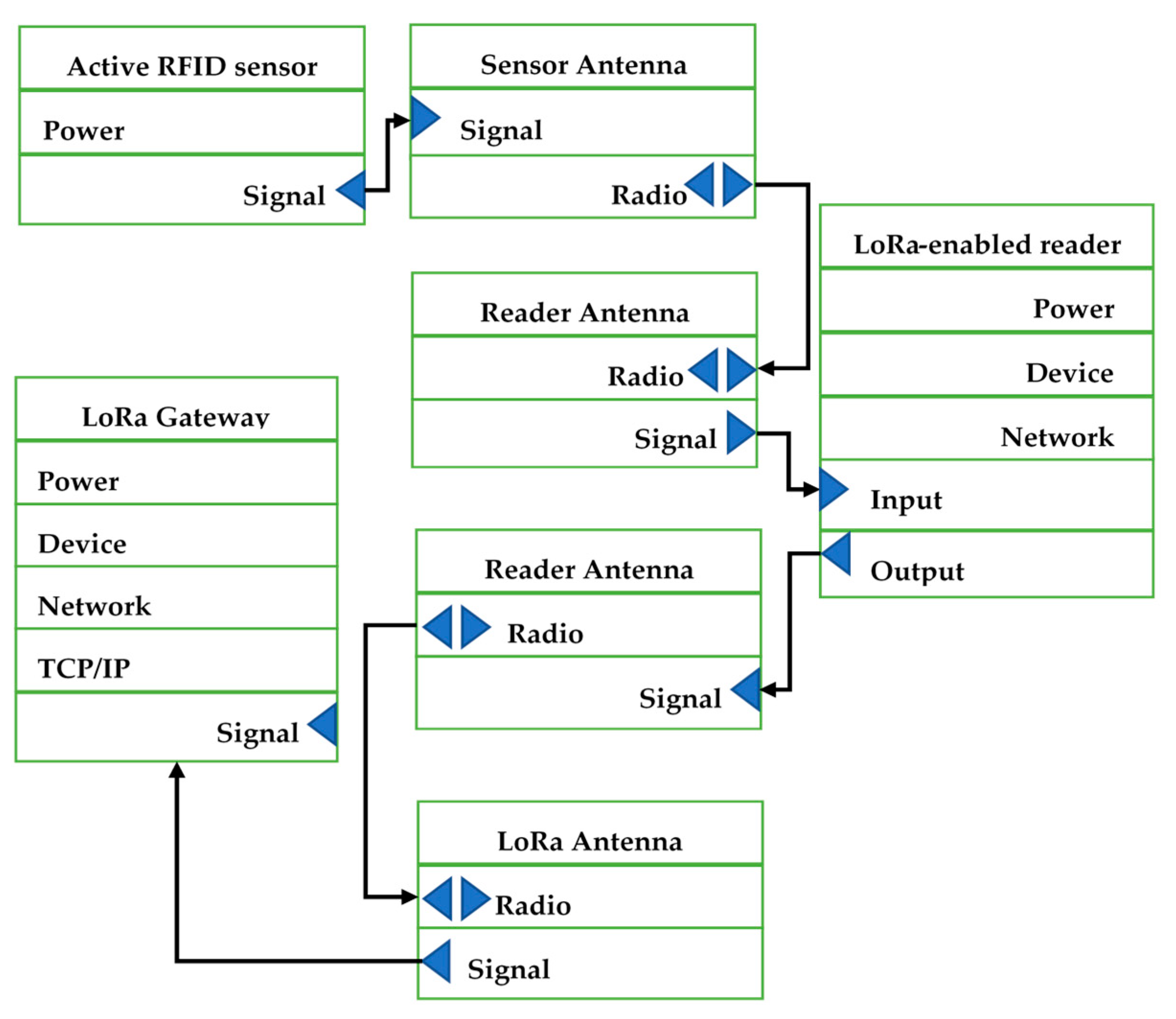
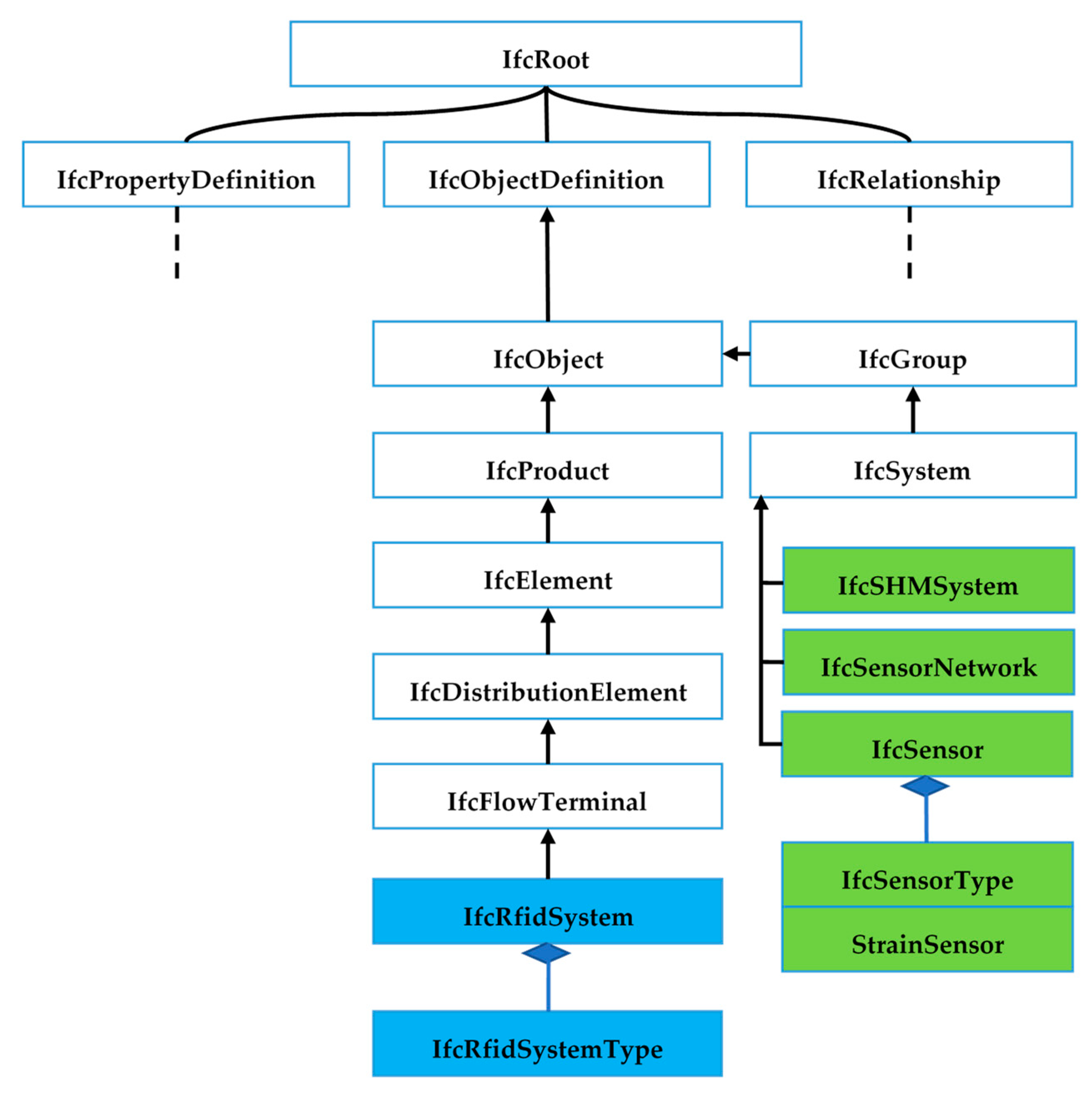
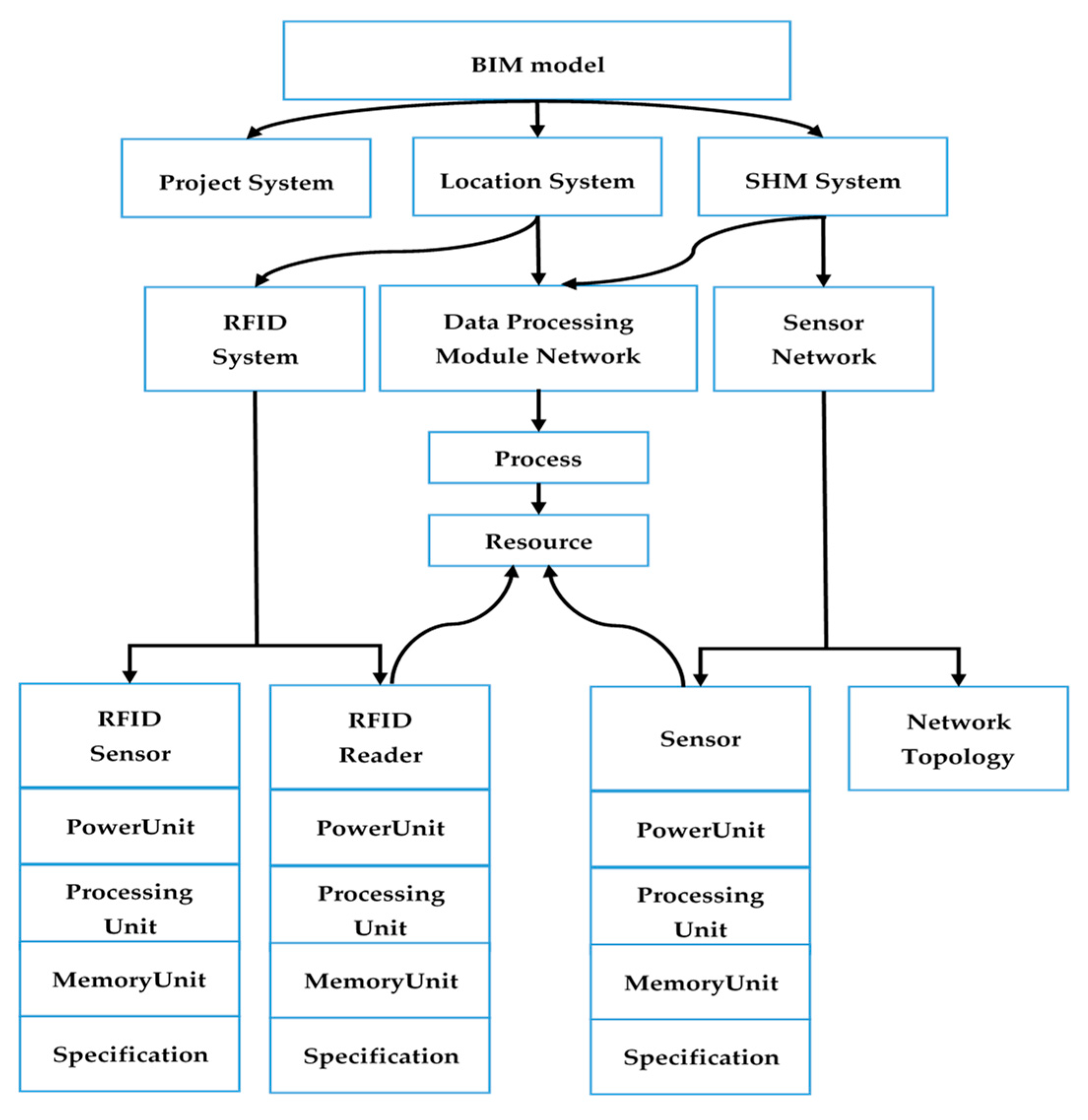
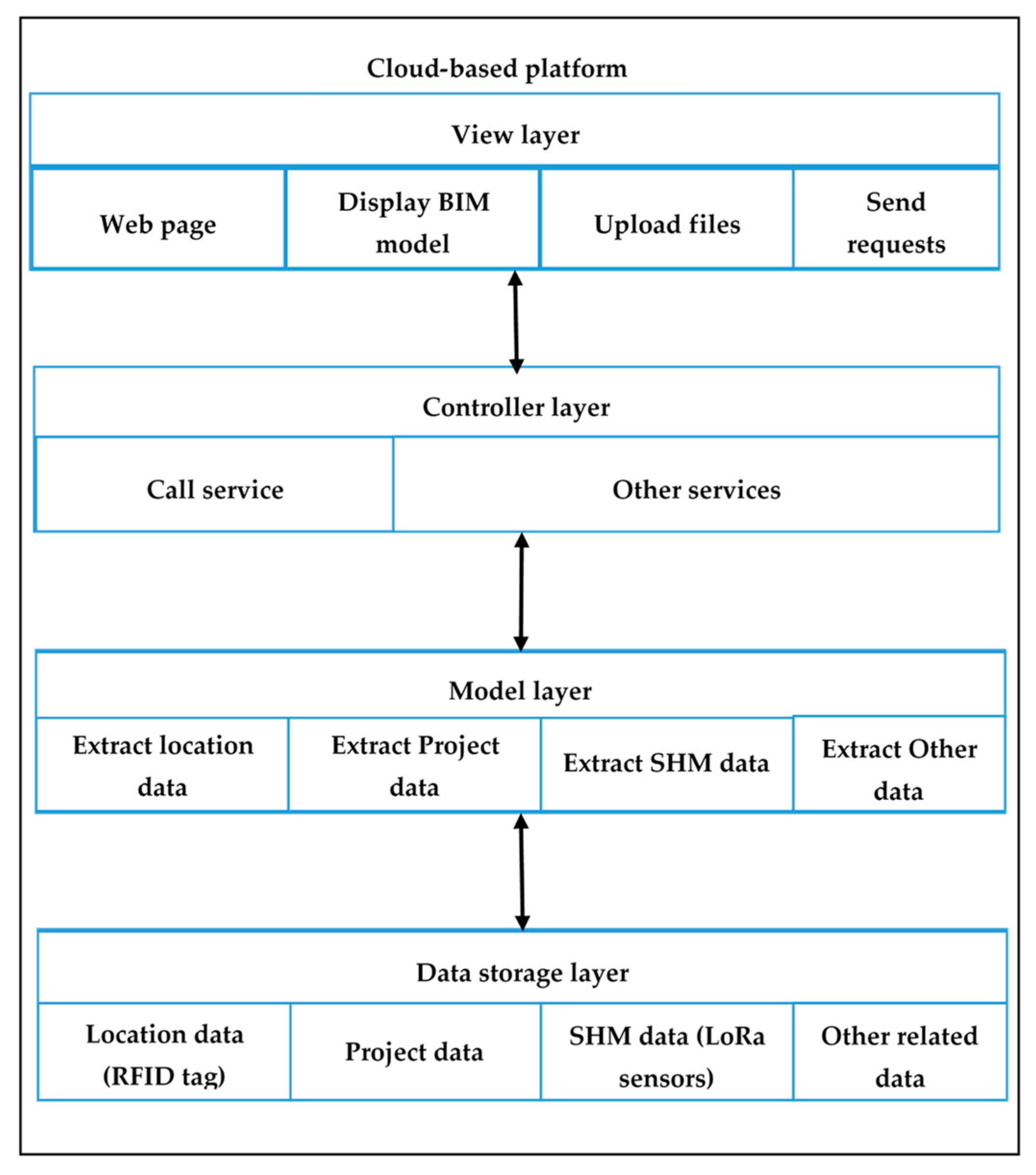
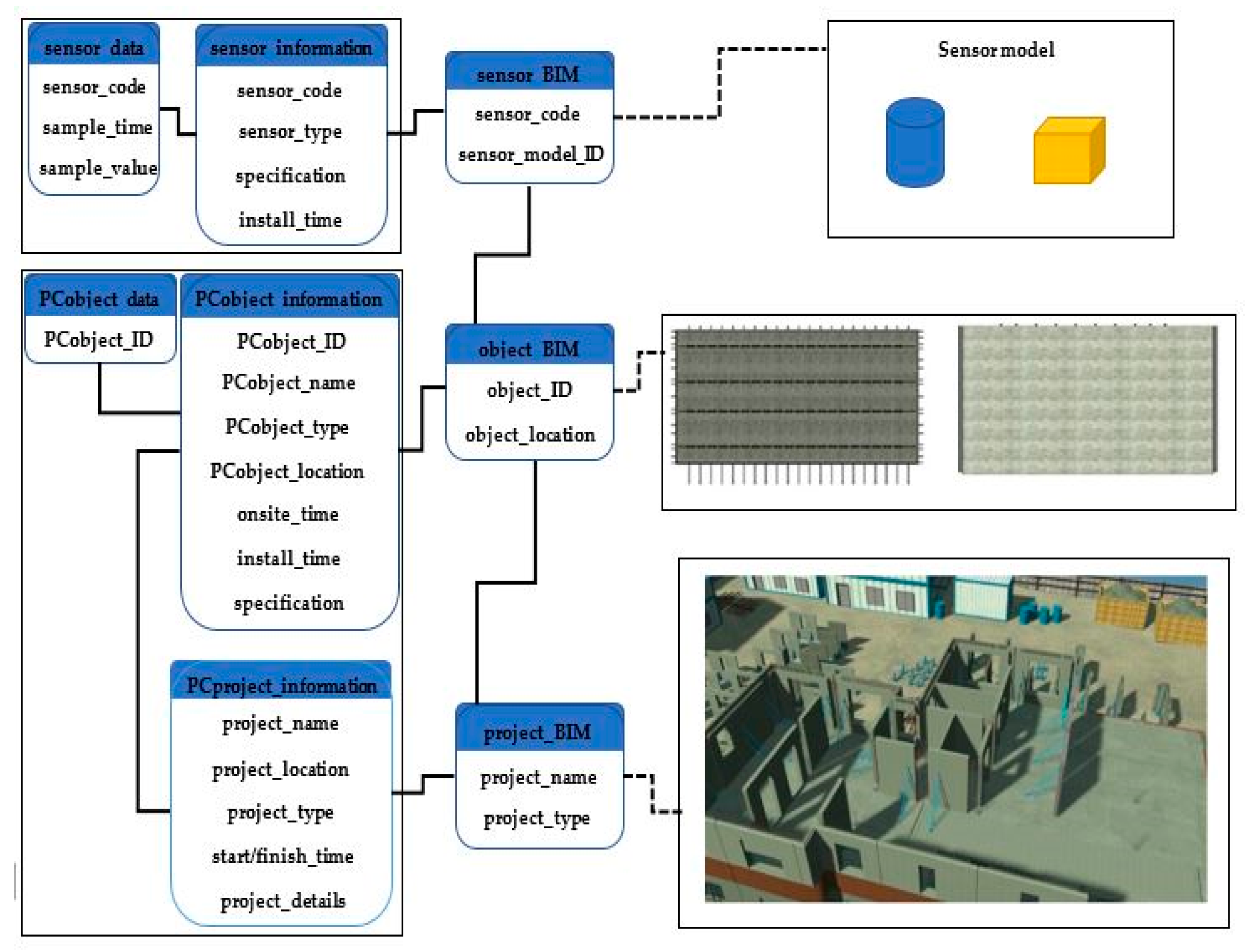
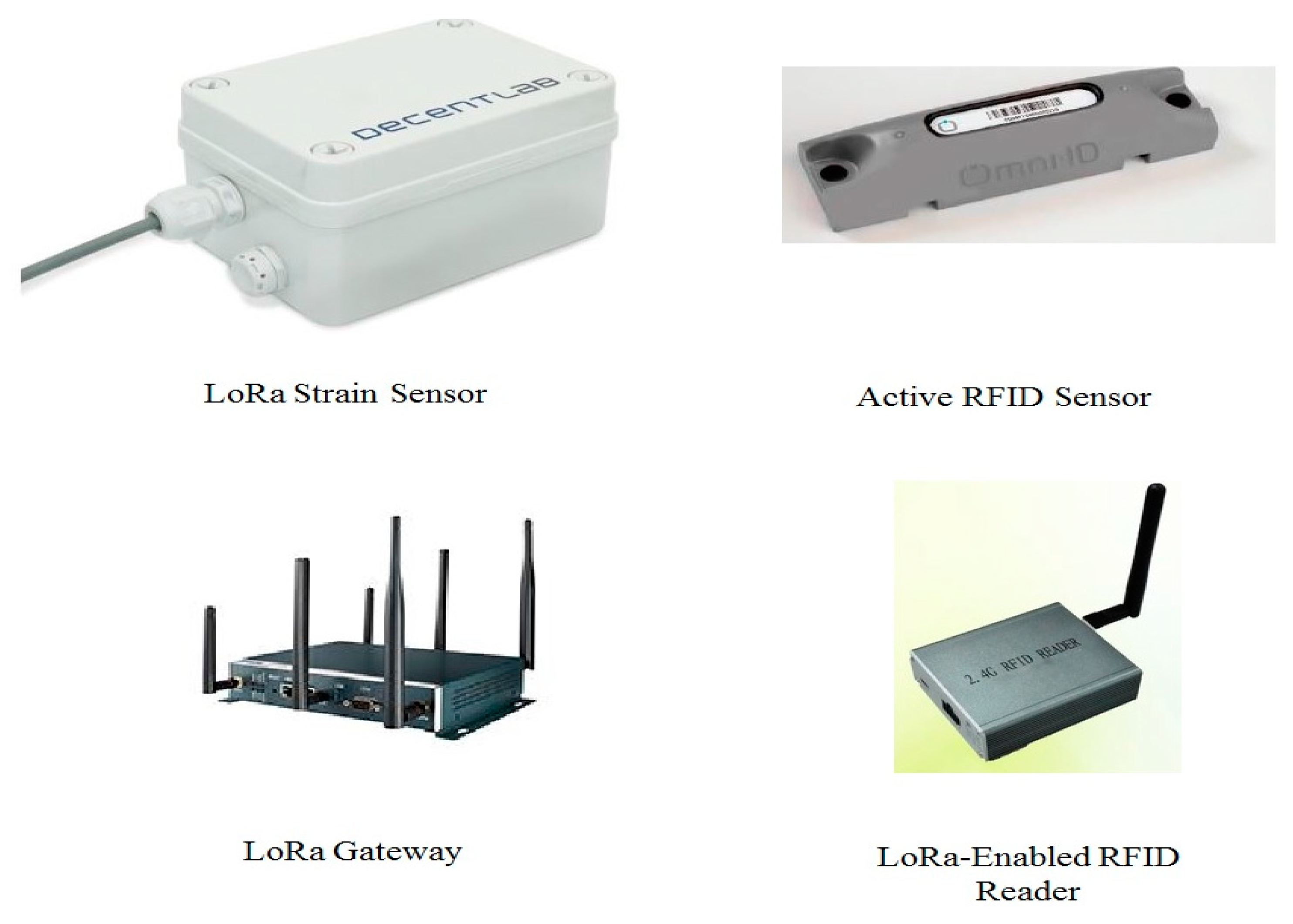
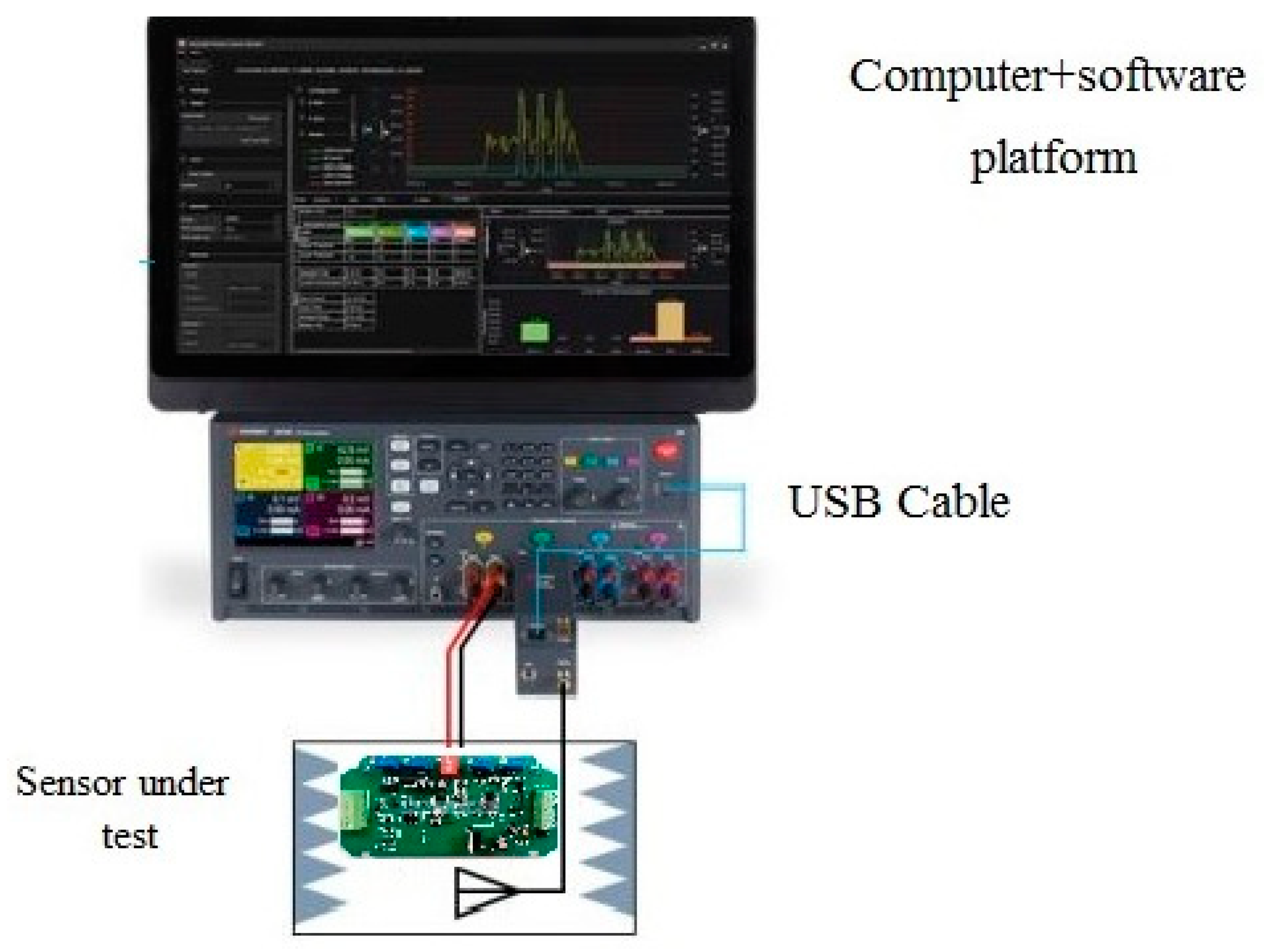
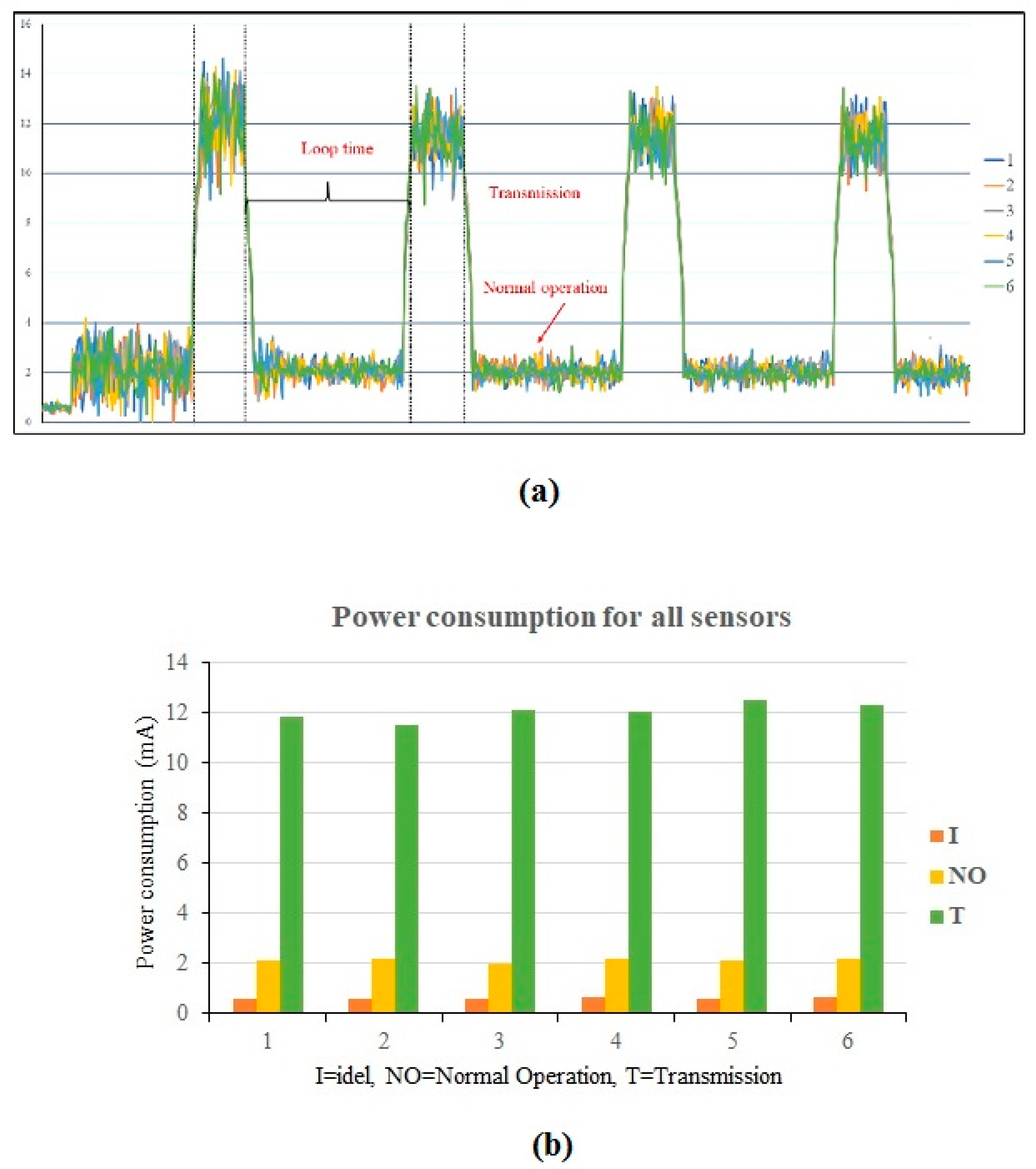
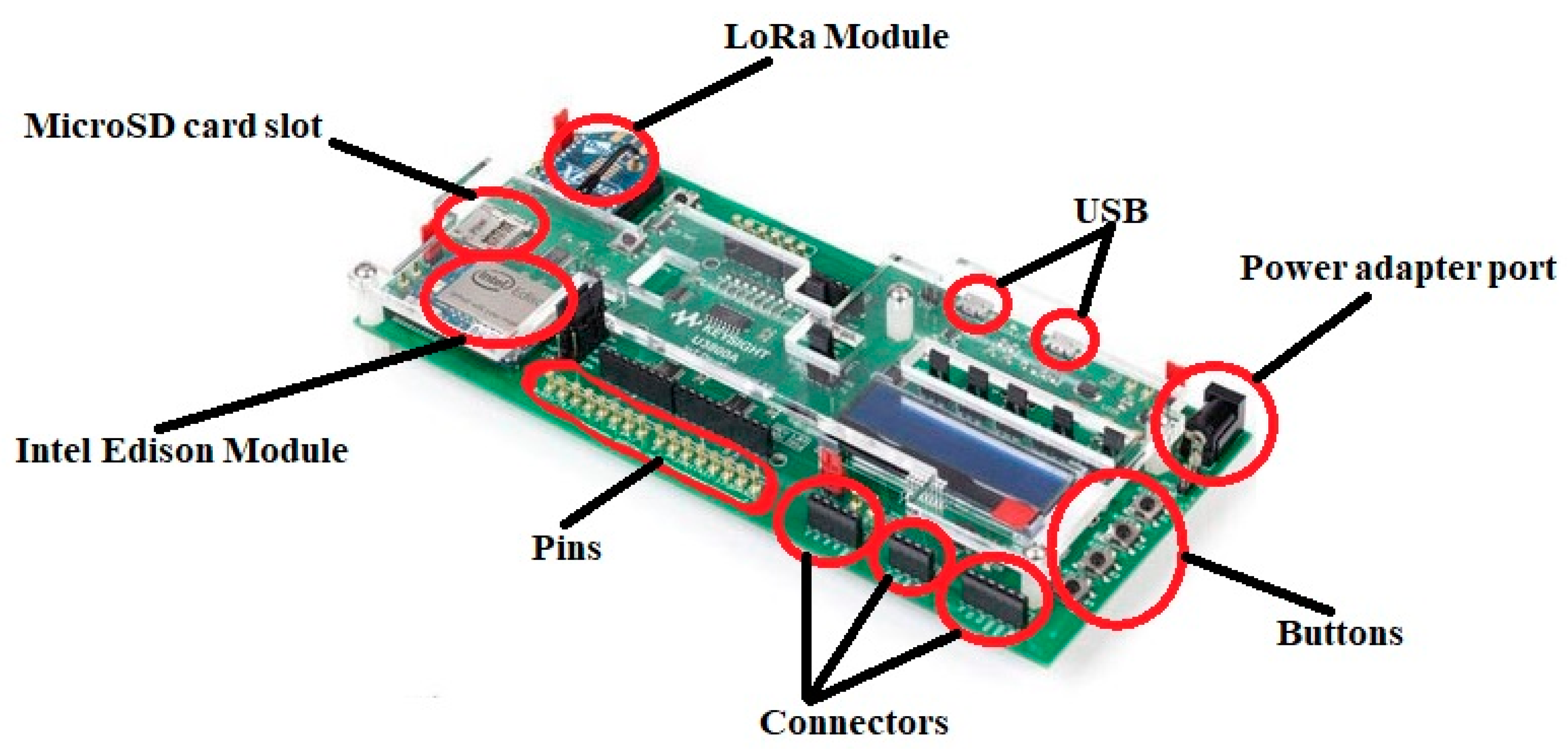
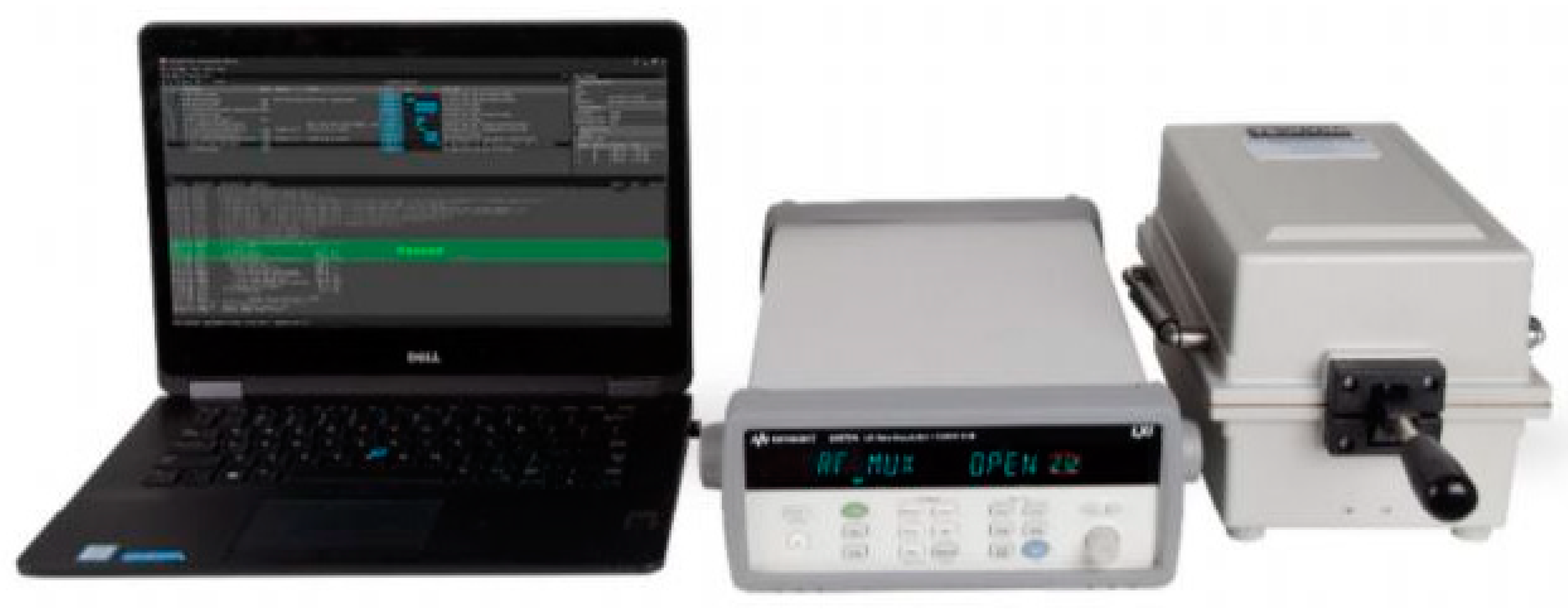
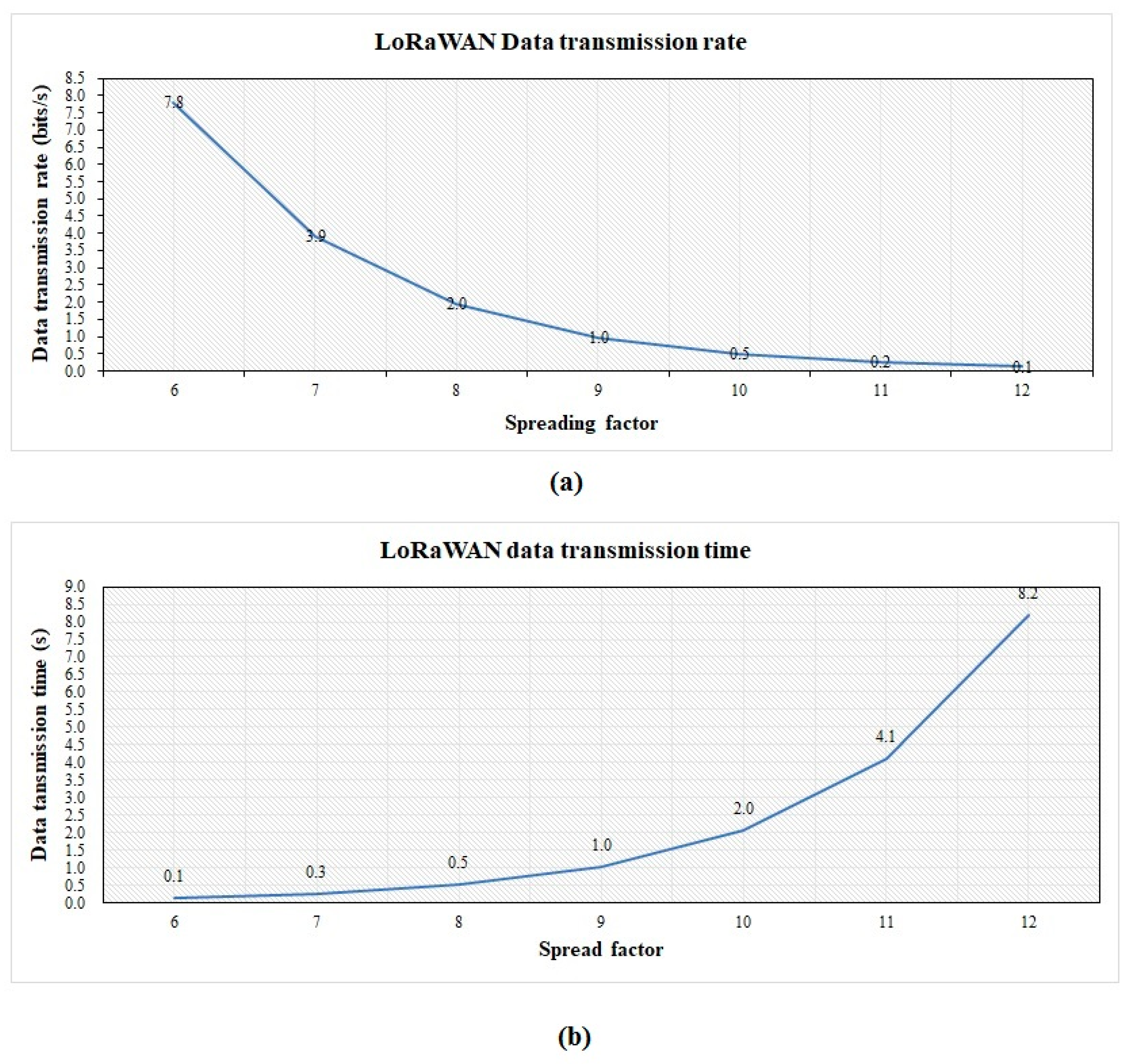

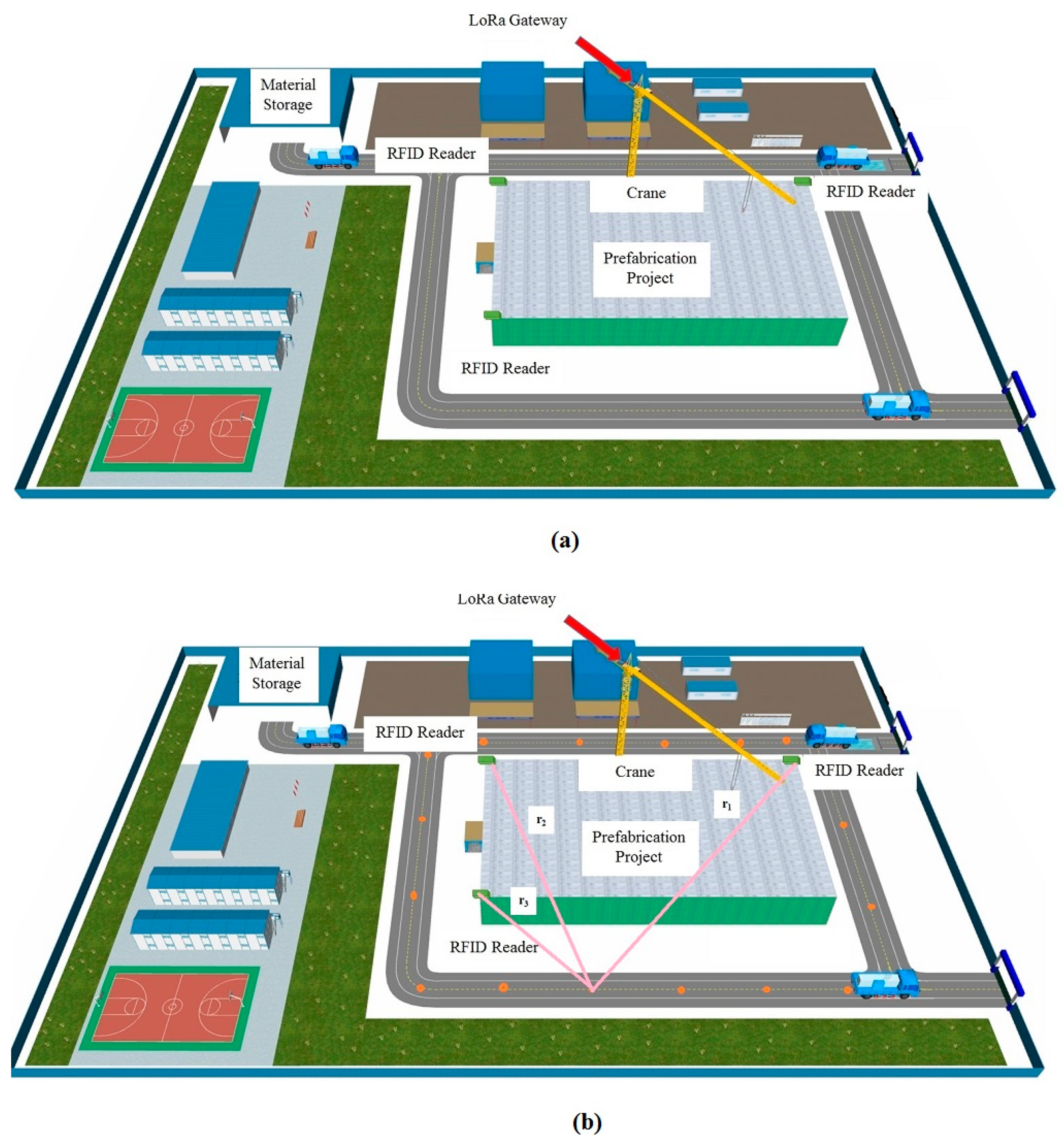
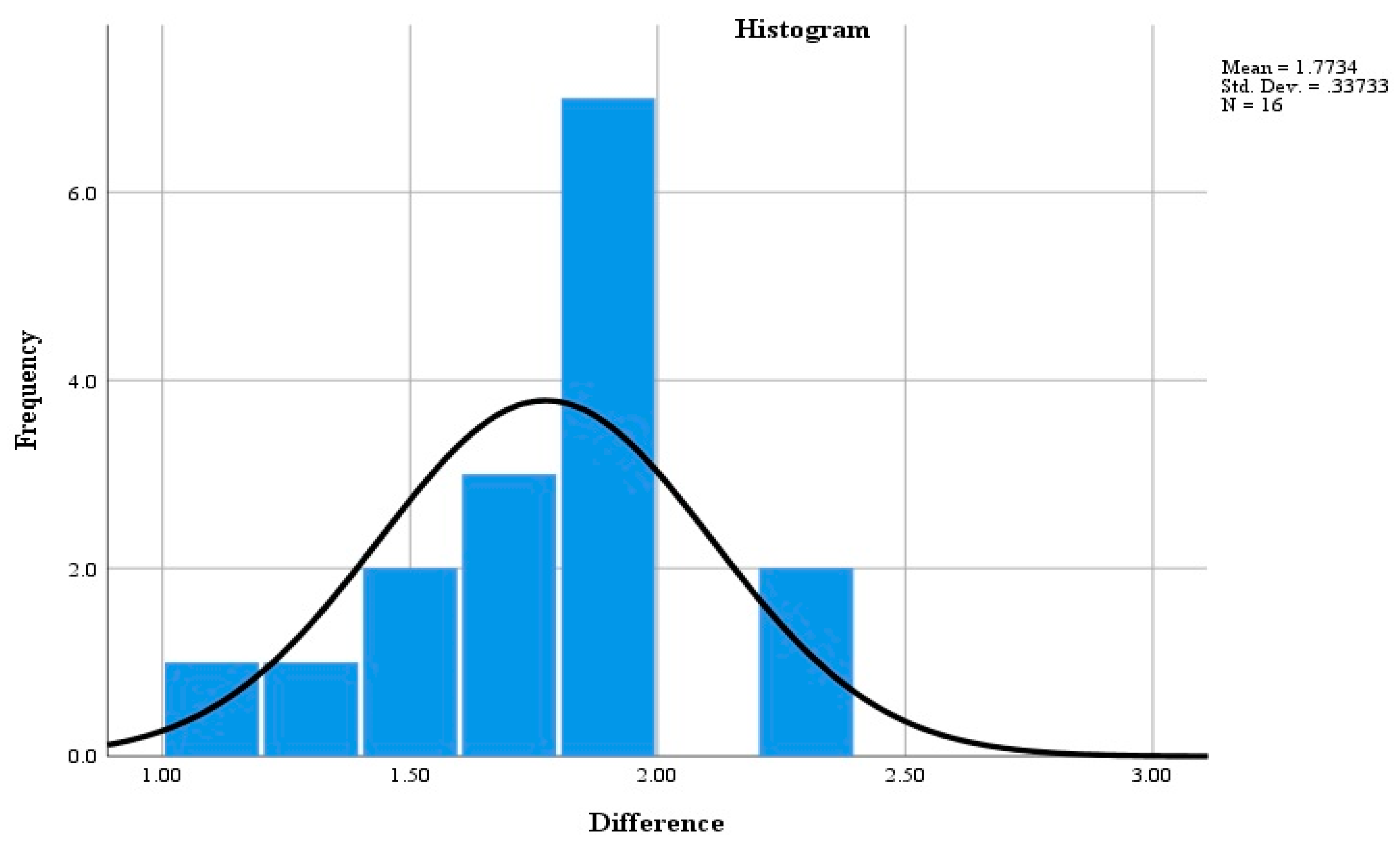
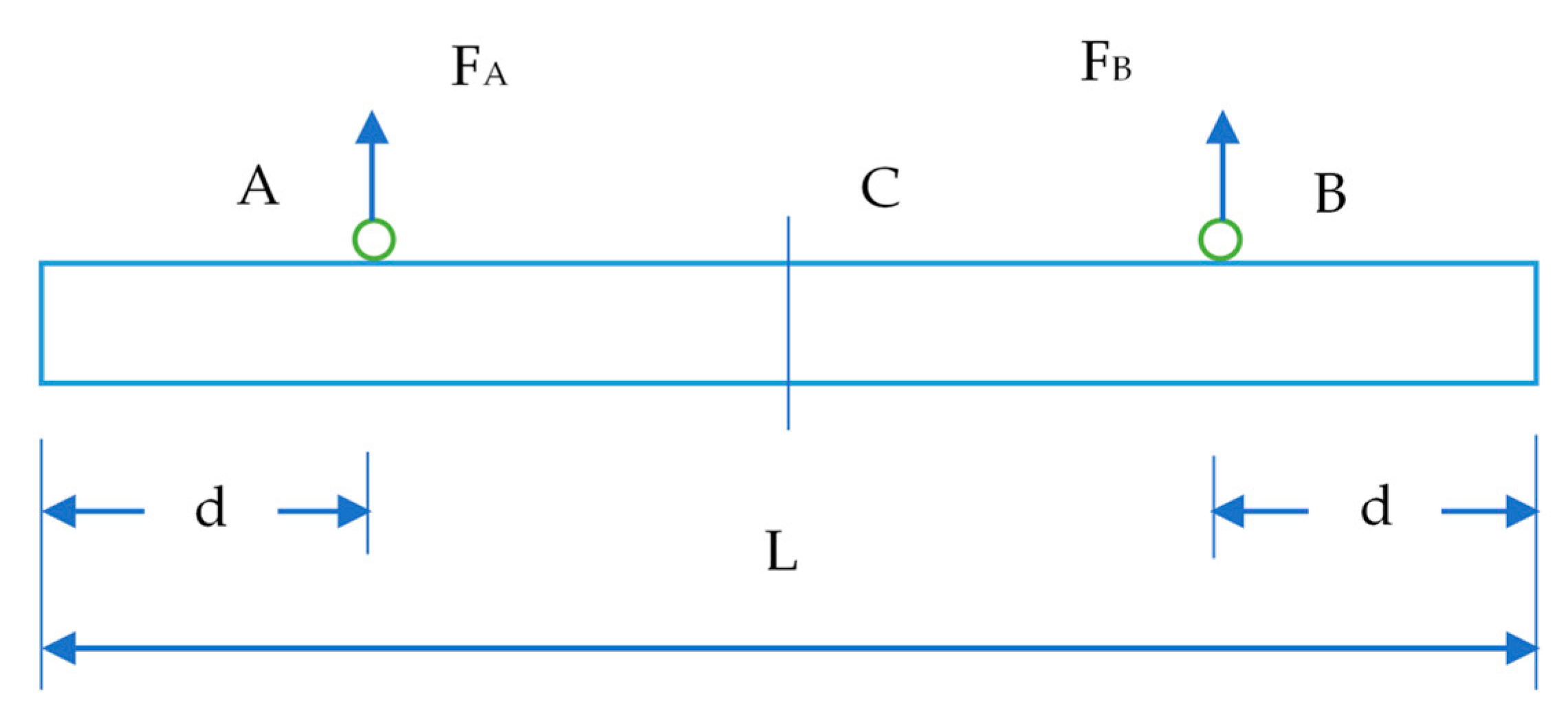

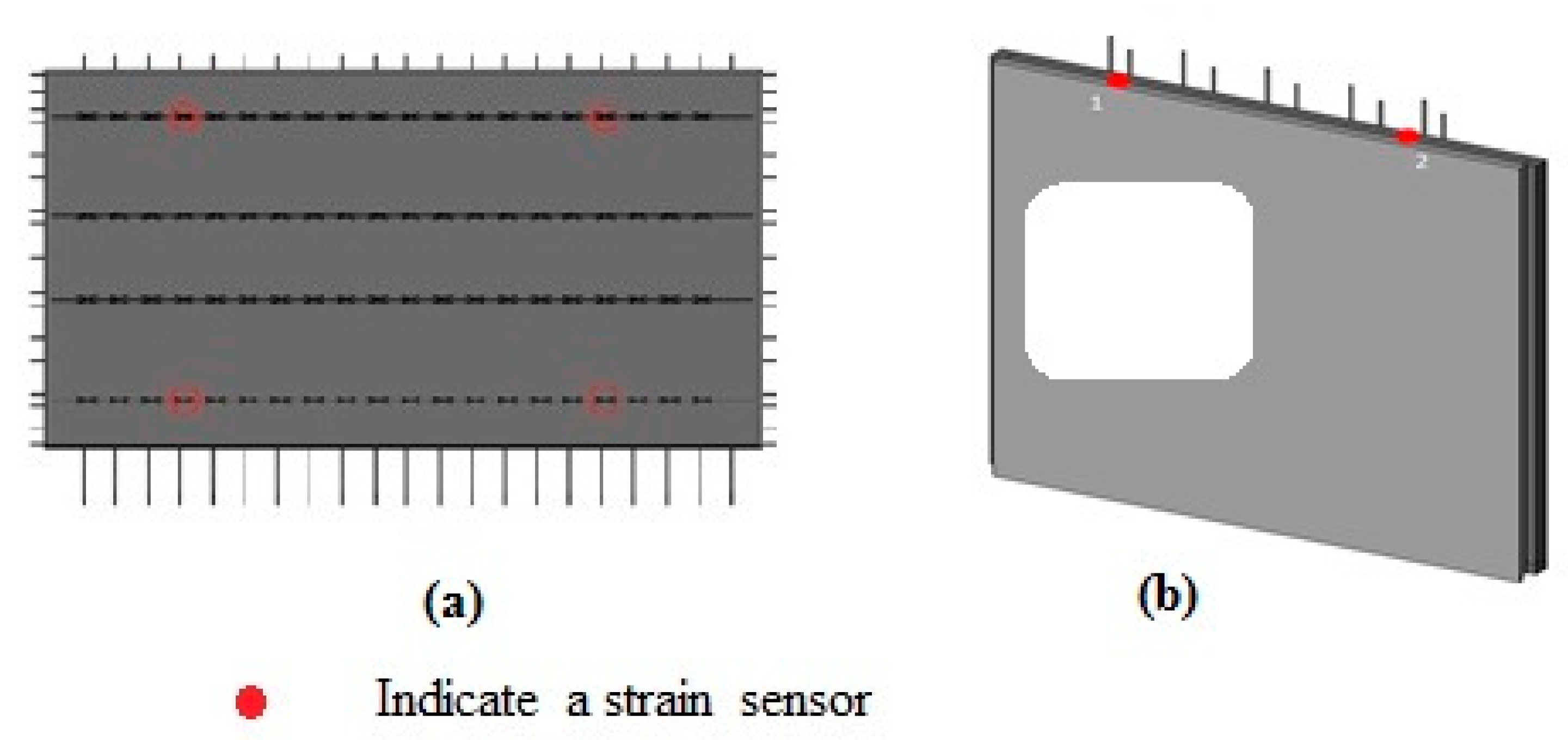
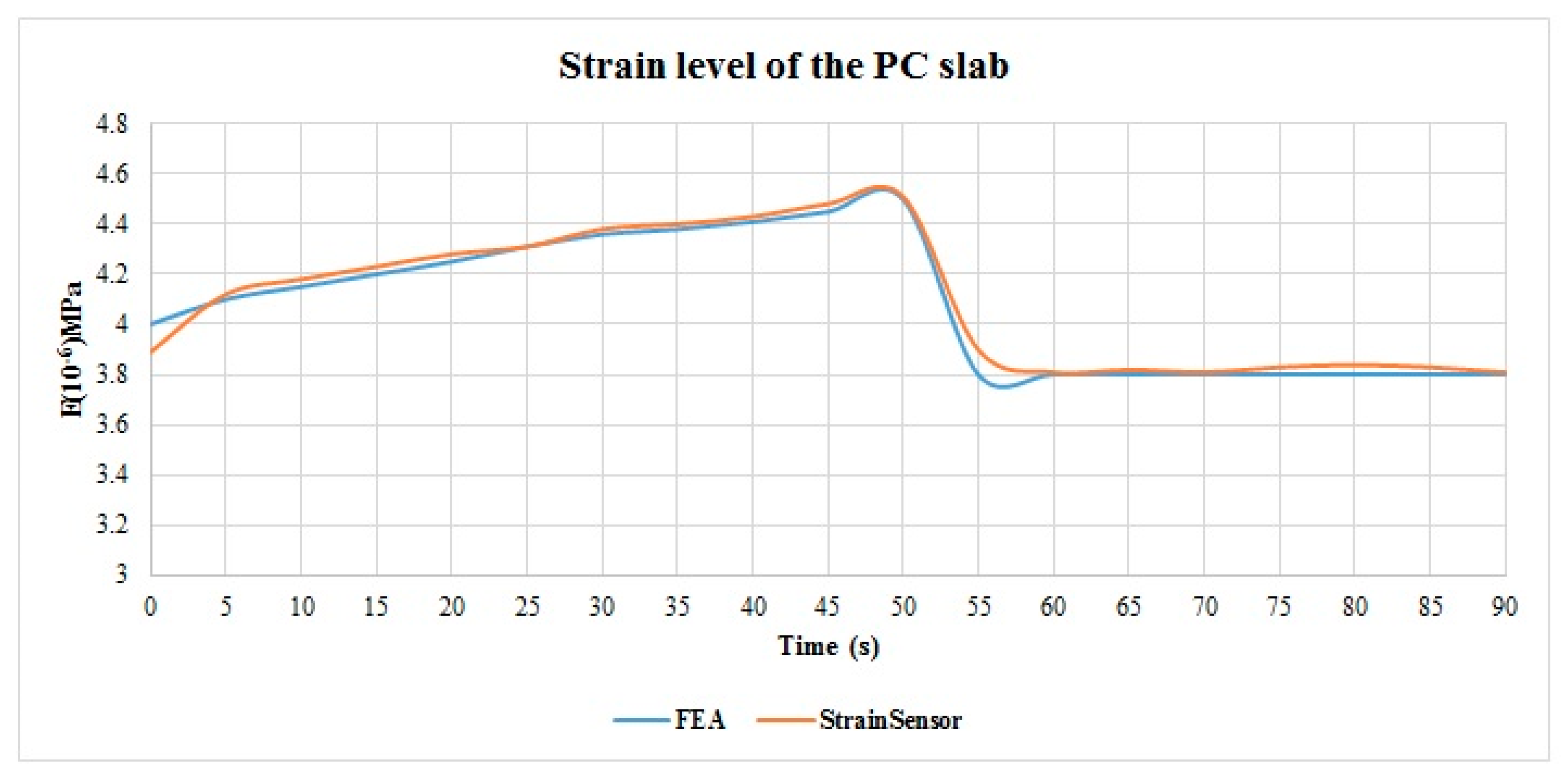
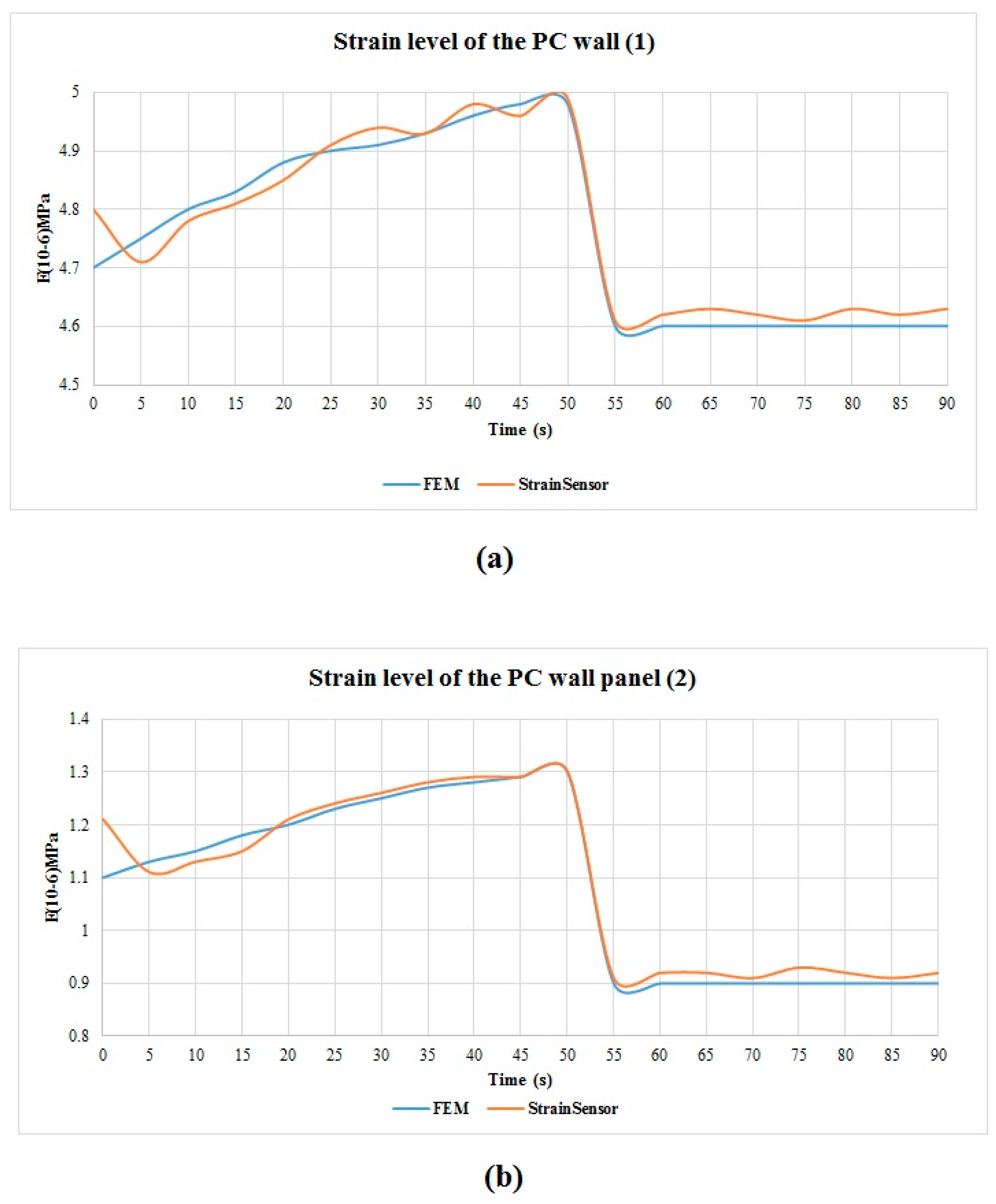

| Parameters | Figures |
|---|---|
| Range | −45–90 μm |
| Base frequency | 16,500 Hz ± 500 Hz |
| Signal nominal | 12,000–18,000 Hz |
| Temperature drift | ± 0.25 Hz/k |
| Parameter | LoRa Values |
|---|---|
| Spreading factor | 27 to 212 |
| Channel Bandwidth | 125 to 500 kHz |
| Uplink data rate | 29–50 kbps |
| Downlink data rate | 27–50 kbps |
| Efficiency (b/s Hz) | 0.12 |
| Doppler sensitivity | Up to 40 ppm |
| Link budget | 156 dB |
| Parameter | Values |
|---|---|
| Size (mm) | 120 × 36 × 30 |
| Weight (g) | 92 |
| Battery length | Up to 5 years |
| Frequency range | 433 MHz |
| Read range | Up to 400 m |
| RFID protocol | IEEE 802.15.4 |
| Operating temperature | −40 °C–60 °C |
| PC Components | t-Value | p-Value |
|---|---|---|
| PC slab | 0.749 | 0.463 |
| PC wall (1) | 1.569 | 0.134 |
| PC Wall (2) | 1.871 | 0.078 |
© 2019 by the authors. Licensee MDPI, Basel, Switzerland. This article is an open access article distributed under the terms and conditions of the Creative Commons Attribution (CC BY) license (http://creativecommons.org/licenses/by/4.0/).
Share and Cite
Zhao, L.; Liu, Z.; Mbachu, J. Development of Intelligent Prefabs Using IoT Technology to Improve the Performance of Prefabricated Construction Projects. Sensors 2019, 19, 4131. https://doi.org/10.3390/s19194131
Zhao L, Liu Z, Mbachu J. Development of Intelligent Prefabs Using IoT Technology to Improve the Performance of Prefabricated Construction Projects. Sensors. 2019; 19(19):4131. https://doi.org/10.3390/s19194131
Chicago/Turabian StyleZhao, Linlin, Zhansheng Liu, and Jasper Mbachu. 2019. "Development of Intelligent Prefabs Using IoT Technology to Improve the Performance of Prefabricated Construction Projects" Sensors 19, no. 19: 4131. https://doi.org/10.3390/s19194131
APA StyleZhao, L., Liu, Z., & Mbachu, J. (2019). Development of Intelligent Prefabs Using IoT Technology to Improve the Performance of Prefabricated Construction Projects. Sensors, 19(19), 4131. https://doi.org/10.3390/s19194131






